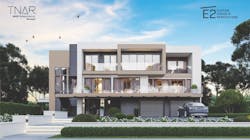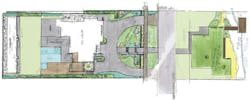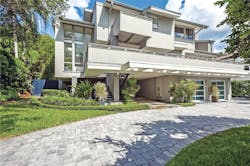The 2021 New American Remodel: A Thoughtful Transformation
The 2021 New American Remodel is a one-of-a-kind example of contemporary architecture. But despite its unique look, it offers lessons that any remodeler or designer can use on how to update a mid-century modern home for 21st Century living without sacrificing its essential character.
Located on the Western shore of the 143-acre Lake Sue in Northeastern Orlando, the home was always one that the neighbors considered quirky. It had five discrete half-levels that gave it a treehouse feel, leading remodeler Rob Smith to dub it “Lake Shore Levels.”
The architect, interior designer, remodeler, and homeowner all wanted to retain as much of this look as possible, but they also wanted to simplify it. The original house was cluttered and busy, resembling a set of boxes haphazardly piled. “It had the potential of being a great house,” recalls interior designer Rob Turner, “but we knew it would take some creativity to unlock its underlying beauty.”
Reimagining the Façade
Turner was the one to first realize that the home’s elevation had the basic elements of Sarasota Modern, an architectural style that emerged from the Sarasota School of Architecture between the 1940s and the 1960s. Hallmarks of the style were large overhangs for shade, as well as rooms arranged to funnel cooling breezes through the interior. “We wanted to keep the angles and geometry; we just needed to give the home some pizazz.”
The home keeps the overhangs and levels, but with a simpler façade, it comes off bolder and more unified. The structure appears stronger.
Transforming the Interior
Similarly dramatic was the interior transformation. The old home was cluttered and busy. One challenge was how to update its look while retaining the basics of its character. While the old home included a handful of open spaces with 15-foot ceilings, several rooms had only eight feet of headroom. “It felt choppy and cramped,” Turner says.
The old house was like a maze, with little staircases leading to the five different levels
One of the project goals was to create a more open feel, but the design and construction team were constrained by structural issues that required them to keep many of the low ceilings.
To compensate, the team settled on a plan whereby rooms with low ceilings would adjoin areas with high ceilings while also offering views to the outside. For instance, the low-ceilinged main kitchen is next to the voluminous great room and has views to the lanai at the back of the house and the lake at the front. The strategy effectively opens spaces that don’t have the vertical volume initially desired.
A Coherent Whole
The team was also able to create a new central stairwell that ties the various levels together into a coherent whole. “The old house was like a maze, with little staircases leading to the five different levels,” designer Turner says. “This one big stair volume connects everything.”
From the exterior, if you know what you’re looking for, you can see the interior’s new layout. As the renderings show, the elements of the remodeled home’s facade have been arranged to mirror its interior spaces. So wherever you see a cube or protruding volume, you’re actually seeing a room. “This is different from a typical house where the exterior shapes don’t tell you what’s going on inside,” Turner says. “It’s a very truthful design.”
The January issue of Pro Remodeler will offer a more in-depth, visual exploration of this exemplary piece of creative design and remodeling.



